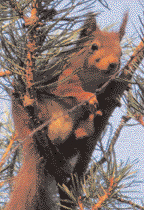|
Wildlife
Newsletter for the Township of Dalkey March 2014 - Michael Ryan |
|
If you spend most of your life living in trees, commuting between them by jumping from branch to branch the last thing you need is days of unrelenting high winds. Leaping from one tree on to a slender branch feet away can be a risk at the best of times but when the branch you are about to jump on to is swaying wildly in the high winds it can get extremely perilous. We were very concerned for a red squirrel we were watching moving through the tops of a group of Scots Pines on Killiney Hill on one of the numerous windy mornings we had for weeks. We thought if the squirrels were active they might stay on the more sheltered side of the hill but this individual was on a tree near the peak of the hill. It was heart in the mouth moments as it jumped from tree to waving tree but it moved effortlessly and didn’t come to any harm. Although red squirrels don’t hibernate, when the weather is bad they will shelter in a nest, called a drey, composed of twigs, hollowed out inside and lined with dried grass, fur and other soft material. Dreys are positioned high in trees often towards the centre of the crown where they are safer from wind damage. Each squirrel might have up to four different winter dreys in which it will sleep at night and shelter from bad weather. Their metabolism will drop so they won’t need to eat as much when they’re inactive. Since the red squirrel reintroduction on the hill there are also a number of very secure squirrel nest boxes so if they need to keep their heads down for a while they shouldn’t have any problem finding a cosy shelter. |
 Male Red Squirrel on Killiney Hill in January Photo M.Ryan |
A few years ago I was very lucky one November afternoon
to be able to watch a red squirrel building a winter drey in a Douglas
Fir, tearing around at a ferocious rate breaking off twigs and bringing
them back to the construction. Maybe it hoped to have its shelter built
before night time, it was certainly busy enough. Last year the squirrel
researchers trapped five red squirrels on Killiney and three of those
were juvenile males, born last year. For a few months previously we
were able to tell the young squirrels from the adults since they hadn’t
been ear tagged but when they were trapped they were all given their
new body decoration for easy identification. Whether the one we’d
seen on the windy tree top was one of last year’s young I could
only speculate but wouldn’t be totally surprised to find that
it was a young male acting a bit recklessly. When the winds did turn bitterly cold in February it brought some welcome returning visitors to the bird feeders. Last year we had at our feeders our first ever visiting Brambling, a Scandinavian member of the finch family. They are regular but not common winter visitors sometimes appearing in small numbers among big flocks of chaffinches but also happy to take advantage of garden feeders. He was back in early February this year and the day after we saw him we had our first Siskins of the year at the nyger seed feeder. But while the cold weather was bringing in some birds to feed in the garden, at the same 25 ? 26 time other birds’ minds were on something else. We’d seen a lovely male Goldfinch doing a seasonally early display, singing from top of a ash tree above the Vico Road. Last year Goldfinches held a territory in a garden on the Vico Road and there was every chance this was the male of that pair. A few days later we watched a robin perched on a bramble doing a fascinating little bobbing and weaving dance, a mating display, crouching then stretching out sideway and shaking his tail while the object of his desire, the female robin looked on. Later that day I was cutting a tree from a ladder when a pair of battling blue tits flew into a conifer then fell out a few inches away, totally oblivious of me as they grappled with each other. Presumably two males already competing for nesting territory. It’s always worth having a look at Dalkey Island to see who’s visiting and at this time of year it can play host to a flock of feeding Brent Geese. They’ll have flown down from Sandymount or the Bull Island where they would have spent the night. Every day many of the Dublin geese will continue down to Wicklow to feed at the reserves at Kilcoole and Newcastle but some will have saved themselves a flight by stopping to feed on the island if the goats have left enough grass for them. Dalkey island is often one of the first resting places of Wheatears, one of our earliest arriving migrants and you can get a crossover of a bird that has just arrived from Africa while the geese feed up before their migration north to Arctic Canada. Leaving out dog hair at this time of year can provide a nice insulating lining for birds nests and it’s never too late to put up bird boxes. Even if they don’t use them this year they’ll get used to them for next year and there’s always the chance a pair of birds whose first attempt at nesting will have failed would be trying to nest again and would avail of them. |
|